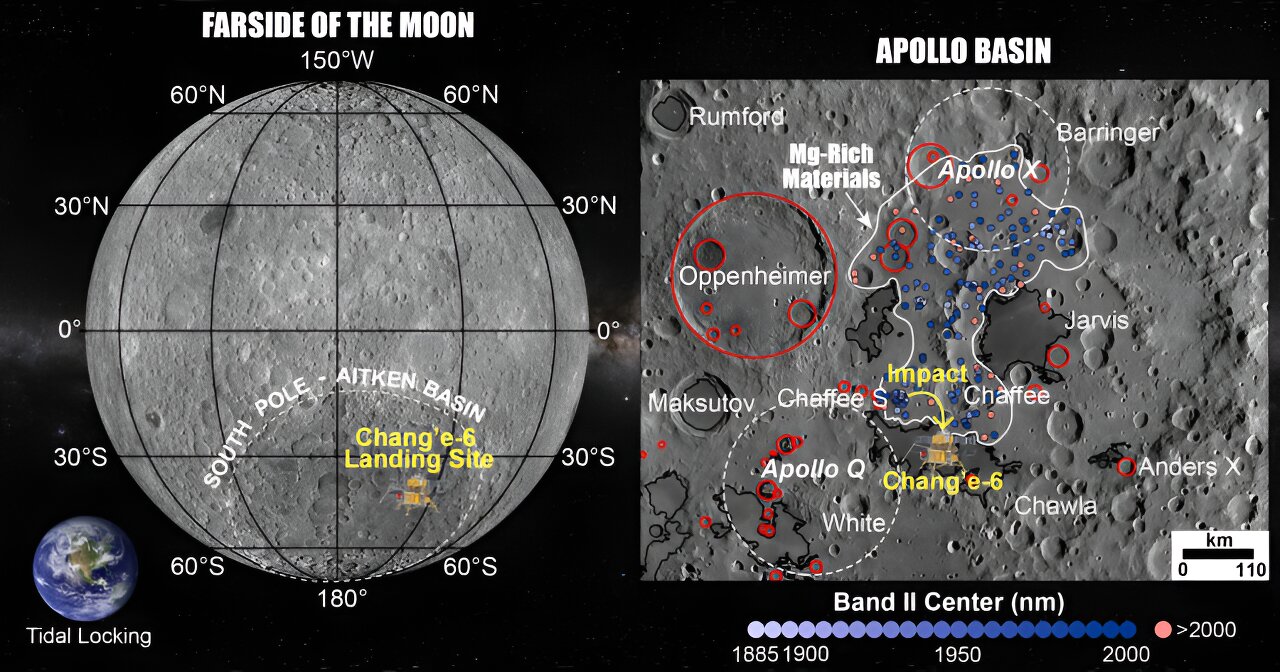Chinese scientists report the first scientific results from the Chang’e-6 mission, which successfully landed on the far side of the Moon this year. They report that the landing site shows evidence of magmatism that once occurred here.

Exploration of the lunar interior
Traces of magmatic activity are found at the landing site of China’s Chang’e-6 spacecraft. It is represented by intrusive (i.e., magma pouring into underground cavities) and extrusive (i.e., pouring to the surface) phenomena.
In addition (Apollo, Luna, and Chang’e-5), samples from the South Pole-Aitken (SPA) basin on the far side of the Moon have long been considered the key to restoring balance to the asymmetric understanding of the Moon and solving the riddle of the lunar dichotomy.
Earlier this year, the Chang’e-6 mission of China’s lunar exploration program, which was successfully launched on May 3, landed on the lunar surface on June 2 and returned to Earth on June 25, delivering a total of 1,935.3 g of lunar soil to Earth. It is the world’s first mission to return lunar soil samples from the far side of the Moon, landing in the south of the Apollo basin within the SPA basin on the far side.
Intrusive magmatism on the Moon
These precious samples may open a window to resolve the long-standing question of the Moon’s dichotomy, overturning man’s view of our nearest neighbor. However, compared to the known volcanism around the Chang’e-6 landing site, the intrusive magmatic activity has a much more unclear presence and origin, hindering the upcoming analysis of the samples when they are available for use.
In a research paper published in The Astrophysical Journal Letters, Dr. Yuqi Qian, Professor Joseph Michalski and Professor Guochun Zhao from the Department of Earth Sciences at the University of Hong Kong (HKU) and their national and international colleagues comprehensively studied the intrusive magmatism and its surroundings using remote sensing data.
The study reveals their widespread distribution and obscure nature, which has important implications for the petrogenesis of lunar plutonic rocks and the Chang’e-6 mission, and will contribute to further exploration of the far side of the Moon.
Results of the study
The study showed that intrusive magmatism was widespread in the SPA Basin. It occurs in a variety of forms, including sills beneath modified craters, linear and ring dikes shown by gravity data, and Mg-mixed intrusions with characteristic spectral absorptions.
These observations are consistent with the intermediate thickness of the crust of SPA, where intrusions are favorable. Upon landing in the SPA Basin, Chang’e-6 most likely collected plutonic rocks pulled and transported by neighboring impact craters to the sampling site, which can be examined in ongoing sample studies.
Scientists found two heavily eroded craters with cracks in the bottom, which inspired them to search for similar objects on the Moon. All signs indicate that intrusive magmatism is very common in the Chang’e-6 sampling region.
This study traced potential plutonic materials in the Chang’e-6 samples and found that there were likely Mg-rich materials, primarily from the western peak ring of the Apollo Basin provided by the Chaffee S crater.
Special geologic rocks on the Moon
These Mg-rich materials contain important information about the origin of the mysterious Mg-poor KREEP rocks. Samples of both intrusive and extrusive magmatism from the never-explored far side, especially the enigmatic Mg mixture, will shed additional light on solving the mystery of lunar dichotomy and a number of fundamental scientific questions related to the secondary crust and early evolution of the Moon.
Prof. Xianhua LI, an academician at the Chinese Academy of Sciences (CAS) and head of Chinese research on lunar samples from the Institute of Geology and Geophysics (IGS), said: “The results of this research set a significant geological framework to study plutonic rocks in the Chang’e-6 samples, especially Mg-suite rocks.”
Prof. Li emphasized: “Their petrogenesis and timing are unclear, and this research would dramatically help to understand their origin mechanism.”
HKU is the first university in Hong Kong to possess lunar soil samples obtained by the Chang’e-5 mission. Based on the foundation of this work, geologists from the University of Hong Kong will also explore Chang’e-6 samples in the future and actively participate in China’s lunar exploration program.
According to phys.org


